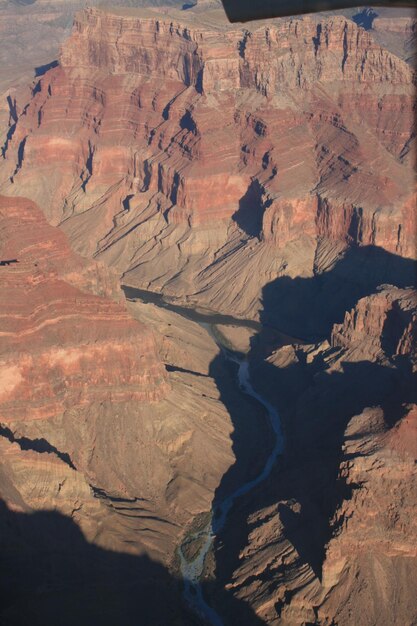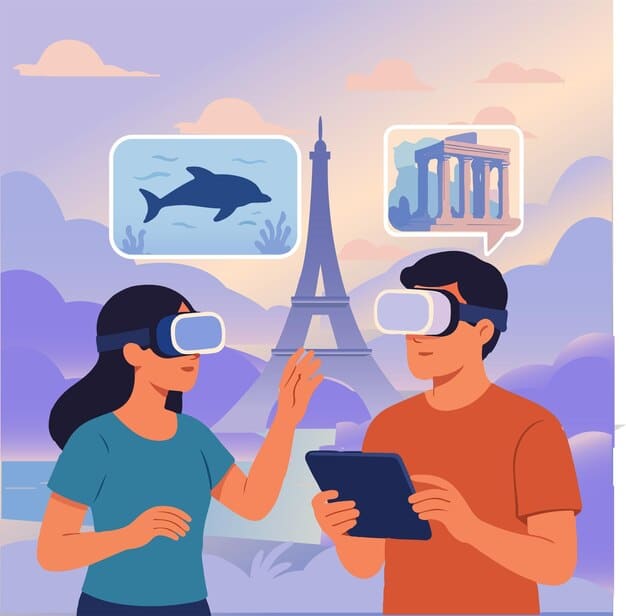Google Earth VR Review: Best Free VR Exploration App in 2025?

Google Earth VR remains a top free VR exploration app in 2025, offering immersive virtual travel experiences with enhanced graphics and expanded features, making it a must-try for both casual users and dedicated VR enthusiasts despite some limitations.
Is Google Earth VR still the best free VR exploration app in 2025? Despite the rapidly evolving VR landscape, this immersive application continues to captivate users with its unparalleled ability to transport them anywhere on the planet. Let’s dive into what makes it a standout experience.
What Makes Google Earth VR Stand Out in 2025?
Google Earth VR has been a favorite among VR enthusiasts since its release, and in 2025, it continues to evolve. Several factors contribute to its enduring appeal.
Enhanced Visuals and Realism
One of the most significant improvements is the enhanced visual fidelity. In 2025, Google Earth VR boasts higher resolution textures and more detailed 3D models, making virtual explorations feel incredibly realistic. This upgrade allows users to appreciate the nuances of different landscapes, from the intricate patterns of urban streets to the rugged terrains of mountain ranges.
Expanded Global Coverage
Google has consistently updated Earth VR with new data, leading to expanded global coverage. Even remote regions and smaller cities benefit from increasingly detailed representations. This makes it possible for users to travel virtually anywhere and access detailed information about previously uncharted territories.

In this section, let’s check the features:
- Immersive Experience: Users can truly feel like they’re visiting different locales.
- Educational Tool: Learn about geography and culture in an engaging way.
- Accessibility: It’s free and available on major VR platforms
The seamless integration of Google’s vast database and VR technology makes this experience continuously rewarding and relevant even as technology evolves.
The User Experience: Navigating the Virtual World
The user experience in Google Earth VR is designed to be intuitive and immersive. Let’s explore the various factors enhancing engagement.
Intuitive Controls and Navigation
Moving around in Google Earth VR is straightforward, with controls optimized for ease of use. Whether using hand controllers or a gamepad, navigating the virtual world feels natural and unrestrictive. Users can quickly zoom in on points of interest, smoothly transition between locations, and adjust viewing angles to their preference.
Interactive Elements and Annotations
New interactive elements enrich the experience by providing additional content and context. Annotations, user-contributed photos, and informative overlays add depth to explorations. Educational insights appear when visiting historical landmarks or natural wonders, merging entertainment with learning.
Multiplayer and Collaborative Exploration
Collaborative features enable multiple users to explore the world together in real-time. This social dimension enhances the VR experience, making it possible for friends and family to embark on virtual journeys. Shared explorations facilitate collaborative learning and create lasting memories, irrespective of geographical boundaries.
Google Earth VR vs. Competitors: What Sets It Apart?
Numerous VR exploration apps compete for user attention, but Google Earth VR distinguishes itself in several crucial ways.
Unmatched Data and Coverage
Google Earth VR leverages Google’s comprehensive global data, including satellite imagery, aerial photography, and 3D models. This expansive database enables unmatched coverage and unparalleled accuracy. Competitors lack the scale and resources needed to replicate the breadth and depth of Google’s geographic information.
Seamless Integration with Google Services
Integration with other Google services enhances the overall user experience. Users can access Google Street View imagery, search for specific locations using Google Search, and view user-generated content from Google Maps. This interconnectivity creates a holistic ecosystem that amplifies the functionality of Google Earth VR.

Ongoing Updates and Improvements
Google demonstrates a continuous commitment to improving Earth VR through regular updates and enhancements. These updates incorporate user feedback, implement new technologies, and expand feature sets, ensuring that the app remains at the forefront of VR exploration. This continual refinement distinguishes it from less frequently updated alternatives.
To better understand its strengths, let’s compare it to alternatives:
- Better data: Google’s database for superior coverage.
- Free access: Many alternatives charge fees.
- Updates: Regular improvements ensure it’s up-to-date.
The scale and constant dedication to user experience keep Google Earth VR ahead of other apps in the segment.
The Educational and Cultural Impact of Google Earth VR
Beyond entertainment, Google Earth VR offers considerable educational and cultural value.
Virtual Field Trips and Learning Experiences
Teachers and educators leverage Google Earth VR to conduct virtual field trips to locations inaccessible through traditional means. These immersive experiences engage students in geographical concepts, historical events, and cultural insights. VR field trips also cultivate curiosity, creativity, and critical thinking skills.
Preservation and Exploration of Cultural Heritage
Google Earth VR plays a significant role in preserving and exploring cultural heritage sites. Virtual tours transport users to historical landmarks, ancient ruins, and archaeological sites, enabling them to appreciate humanity’s collective heritage. Moreover, these virtual experiences capture artifacts and architecture threatened by climate change, conflict, or neglect.
Promoting Global Awareness and Empathy
By allowing users to explore different countries, regions, and cultures, Google Earth VR fosters global awareness and empathy. Immersive experiences expose users to diverse landscapes, lifestyles, and challenges, promoting understanding and compassion. This cross-cultural exchange helps break down stereotypes and build bridges across communities.
Potential Drawbacks and Areas for Improvement
While Google Earth VR offers a compelling experience, it is not without limitations.
Hardware Requirements and Performance
Running Google Earth VR requires robust hardware capabilities, including powerful processors, dedicated graphics cards, and high-resolution VR headsets. This restricts accessibility for users with older or less capable systems. Optimizing performance for a broader range of hardware remains an ongoing objective.
Data Accuracy and Update Freshness
While the global data coverage is impressive, inaccuracies and inconsistencies can still occur. The accuracy of 3D models, satellite imagery, and other geographic data depends on the acquisition and processing timelines. Ensuring timely updates and rectifying errors are essential for maintaining credibility.
Limited Offline Functionality
Google Earth VR relies heavily on an internet connection to stream geographic data in real-time. This reduces accessibility for users with limited or unreliable internet access. Incorporating significant offline functionality would expand accessibility to remote areas and users with bandwidth constraints.
The Future of Virtual Exploration with Google Earth VR
The future of Google Earth VR promises even more innovative features and enhancements.
Integration with Advanced VR Technologies
Integration with emerging VR technologies such as augmented reality (AR) and mixed reality (MR) could revolutionize the experience. Imagine overlaying real-time information onto virtual landscapes or blending virtual elements with the physical world. These integrations offer exciting possibilities for enriching virtual exploration and discovery.
AI-Powered Insights and Personalization
Leveraging AI and machine learning could personalize the user experience and provide tailored insights. AI-powered algorithms could analyze user preferences, recommend points of interest, and curate custom tours. These adaptive features would enhance engagement and satisfaction.
Enhanced Social and Community Features
Expanding social media features and community engagement could foster deeper connections among users. Integrating forums, collaborative projects, and shared annotations would transform Google Earth VR into a platform for global collaboration and storytelling.
| Key Point | Brief Description |
|---|---|
| 🌍 Immersive Experience | Explore locations worldwide with enhanced visuals. |
| 🤝 Collaborative Exploration | Share virtual journeys with friends and family. |
| 📚 Educational Tool | Learn about geography and culture interactively. |
| 💡 Continuous Improvement | Ongoing updates with better features and data. |
Is Google Earth VR free to use?
▼
Yes, Google Earth VR is available for free on major VR platforms like Steam and the Oculus Store, making it accessible to a wide audience seeking virtual exploration experiences.
How accurate is the data in Google Earth VR?
▼
Google Earth VR uses up-to-date satellite imagery and 3D models. However, accuracy can vary by location. Areas with higher population have better details.
Can I use Google Earth VR offline?
▼
No, The software relies significantly on a stable internet connection to download geo data. Offline mode is very limited.
What VR headsets are compatible with Google Earth VR?
▼
Google Earth VR supports various VR headsets, including Oculus Rift, HTC Vive, and Windows Mixed Reality headsets, ensuring compatibility for many VR enthusiasts.
Does Google Earth VR have multi-user support?
▼
Yes, you can explore the world with friends and family together in Google Earth VR, sharing virtual journeys and experiences.
Conclusion
As of 2025, Google Earth VR remains a standout free VR exploration app. Its combination of comprehensive data, intuitive controls, and ongoing updates ensures an immersive and educational experience. While it has areas for improvement, its benefits are many, making it a compelling choice for those seeking virtual adventures.





